Related Research Articles

Agnes Bernice Martin was an American abstract painter known for her minimalist style and abstract expressionism. Born in Canada, she moved to the United States in 1931, where she pursued higher education and became a U.S. citizen in 1950. Martin's artistic journey began in New York City, where she immersed herself in modern art and developed a deep interest in abstraction. Despite often being labeled a minimalist, she identified more with abstract expressionism. Her work has been defined as an "essay in discretion, inwardness and silence."

Gillian Ayres was an English painter. She is best known for abstract painting and printmaking using vibrant colours, which earned her a Turner Prize nomination.

Helen Frankenthaler was an American abstract expressionist painter. She was a major contributor to the history of postwar American painting. Having exhibited her work for over six decades, she spanned several generations of abstract painters while continuing to produce vital and ever-changing new work. Frankenthaler began exhibiting her large-scale abstract expressionist paintings in contemporary museums and galleries in the early 1950s. She was included in the 1964 Post-Painterly Abstraction exhibition curated by Clement Greenberg that introduced a newer generation of abstract painting that came to be known as color field. Born in Manhattan, she was influenced by Greenberg, Hans Hofmann, and Jackson Pollock's paintings. Her work has been the subject of several retrospective exhibitions, including a 1989 retrospective at the Museum of Modern Art in New York City, and been exhibited worldwide since the 1950s. In 2001, she was awarded the National Medal of Arts.

Lenore "Lee" Krasner was an American painter and visual artist active primarily in New York whose work has been associated with the Abstract Expressionist movement. She received her early academic training at the Women's Art School of Cooper Union, and the National Academy of Design from 1928 to 1932. Krasner's exposure to Post-Impressionism at the newly opened Museum of Modern Art in 1929 led to a sustained interest in modern art. In 1937, she enrolled in classes taught by Hans Hofmann, which led her to integrate influences of Cubism into her paintings. During the Great Depression, Krasner joined the Works Progress Administration's Federal Art Project, transitioning to war propaganda artworks during the War Services era.
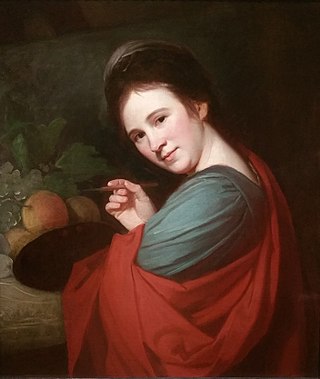
Mary Moser was an English painter and one of the most celebrated female artists of 18th-century Britain. One of only two female founding members of the Royal Academy in 1768, Moser painted portraits but is particularly noted for her depictions of flowers.
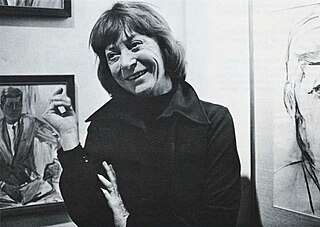
Elaine Marie Catherine de Kooning was an Abstract Expressionist and Figurative Expressionist painter in the post-World War II era. She wrote extensively on the art of the period and was an editorial associate for Art News magazine.

Sir William Allan was a distinguished Scottish historical painter known for his scenes of Russian life. He became president of the Royal Scottish Academy and was made a Royal Academician.
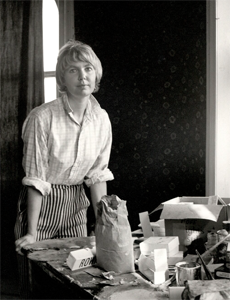
Sandra Betty Blow was an English abstract painter and one of the pioneers of the British abstract movement of the 1950s. Blow's works are characteristically large scale, colourful abstract collages made from discarded materials.

Dame Elizabeth Violet Blackadder, Mrs Houston, was a Scottish painter and printmaker. She was the first woman to be elected to both the Royal Scottish Academy and the Royal Academy of Arts.

William Gear RA RBSA was a Scottish painter, most notable for his abstract compositions.

Amy Sillman is a New York-based visual artist, known for process-based paintings that move between abstraction and figuration, and engage nontraditional media including animation, zines and installation. Her work draws upon art historical tropes, particularly postwar American gestural painting, as both influences and foils; she engages feminist critiques of the discourses of mastery, genius and power in order to introduce qualities such as humor, awkwardness, self-deprecation, affect and doubt into her practice. Profiles in The New York Times, ARTnews, Frieze, and Interview, characterize Sillman as championing "the relevance of painting" and "a reinvigorated mode of abstraction reclaiming the potency of active brushwork and visible gestures." Critic Phyllis Tuchman described Sillman as "an inventive abstractionist" whose "messy, multivalent, lively" art "reframes long-held notions regarding the look and emotional character of abstraction."
Norman Ackroyd was an English visual artist known primarily for his etchings and work with aquatint. He lived and was based in Bermondsey, London.
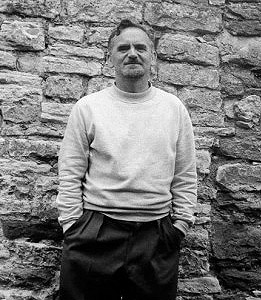
William Scott was a prominent abstract painter from Northern Ireland, known for his themes of still life, landscape and female nudes. He is the most internationally celebrated of 20th-century Ulster painters. His early life was the subject of the film Every Picture Tells a Story, made by his son James Scott.
Sir Richard Sheridan Patrick Michael Aloysius Franklin Bowling(né Richard Sheridan Franklin Bowling; born 26 February 1934), known as Frank Bowling, is a British artist who was born in British Guiana. He is particularly renowned for his large-scale, abstract "Map" paintings, which relate to abstract expressionism, colour field painting and lyrical abstraction. Bowling has been described as "one of Britain’s greatest living abstract painters", as "one of the most distinguished black artists to emerge from post-war British art schools" and as a "modern master". British cultural critic and theorist Stuart Hall situates Bowling’s career within a first generation, or “wave” of post-war, Black-British art, one characterised by postwar politics and British decolonisation. He is the first black artist to be elected a member of the Royal Academy of Arts.
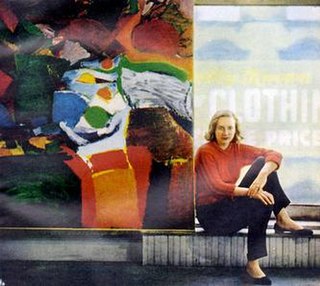
Grace Hartigan was an American abstract expressionist painter and a significant member of the vibrant New York School of the 1950s and 1960s. Her circle of friends, who frequently inspired one another in their artistic endeavors, included Jackson Pollock, Larry Rivers, Helen Frankenthaler, Willem and Elaine de Kooning and Frank O'Hara. Her paintings are held by numerous major institutions, including the Museum of Modern Art in New York City. As director of the Maryland Institute College of Art's Hoffberger School of Painting, she influenced numerous young artists.
Ellen Gallagher is an American artist. Her work has been shown in numerous solo and group exhibitions and is held in the permanent collections of many major museums. Her media include painting, works on paper, film and video. Some of her pieces refer to issues of race, and may combine formality with racial stereotypes and depict "ordering principles" society imposes.

Gertrude Alice Meredith Williams, who generally went by the name of Alice Meredith Williams, was a British sculptor, painter, illustrator and stained glass designer.
Barbara Davis Rae CBE RA FRSE is a Scottish painter and printmaker. She is a member of the Royal Scottish Academy and the Royal Academy of Arts.
John Blair was a Scottish painter, predominantly of watercolour landscapes. Of humble beginnings in Berwickshire, he moved to Edinburgh to study and spent the rest of his life there. His paintings mainly reflect the landscapes around him, both of urban settings and also of the castles, sea and lochs of the Borders, although he also painted figures and still lifes. As well as his original work, his paintings were viewed by a wide audience in the form of picture postcards, book endpapers and illustrations.
Rachel Jones is a British visual artist. She has exhibited work in the UK at galleries and institutions including Thaddaeus Ropac, The Sunday Painter and the Royal Scottish Academy, and has been artist-in-residence at the Chinati Foundation (2019) and Masterworks Museum of Bermuda Art in (2016). Her work is in collections of The Tate, Arts Council England, Hepworth Wakefield, the Museum of Fine Arts, Houston, and the Institute of Contemporary Art, Miami.
References
- ↑ "Mary Ramsden". Royal Academy of Arts. Retrieved 22 August 2021.
- ↑ Farrell, Aimee (15 December 2015). "A Tantalizing, Mysterious Art Book (or Is it Book Art?)". The New York Times. ISSN 0362-4331 . Retrieved 15 March 2018.
- ↑ Elderton, Louisa (14 March 2015). "In Review: Mary Ramsden". Frieze (170). frieze.com. Retrieved 15 March 2018.
- ↑ "Mary Ramsden: Couples Therapy". Time Out London. Retrieved 19 March 2018.
- ↑ "Top artists backing Leith School of Art fundraiser". The Edinburgh Reporter. 14 March 2017. Retrieved 19 March 2018.
- 1 2 "Catching up with... Mary Ramsden". Royal Academy of Arts. 20 March 2015. Retrieved 19 March 2018.
- ↑ "Mary Ramsden: (In / It)". Aspen Art Museum. 2016. Retrieved 19 March 2018.
- ↑ Travers, Andrew (12 January 2017). "Black Mirrors". The Aspen Times. Retrieved 19 March 2018.
- ↑ "Is This Mary Ramsden's Dirtiest Selfie?". Amuse. 16 December 2015. Retrieved 19 March 2018.